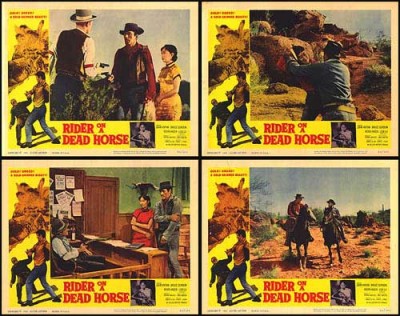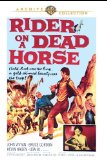| Reviews & Columns |
|
Reviews DVD TV on DVD Blu-ray 4K UHD International DVDs In Theaters Reviews by Studio Video Games Features Collector Series DVDs Easter Egg Database Interviews DVD Talk Radio Feature Articles Columns Anime Talk DVD Savant Horror DVDs The M.O.D. Squad Art House HD Talk Silent DVD
|
DVD Talk Forum |
|
|
| Resources |
|
DVD Price Search Customer Service #'s RCE Info Links |
|
Columns
|
|
|
Rider On a Dead Horse
A Warner Archive release, Rider on a Dead Horse utilizes original film elements in great shape, with this 16:9 enhanced widescreen, black-and-white transfer clean and crisp.
The movie opens with gold prospectors Hayden (Vivyan), Senn (Bruce Gordon), and Sam (Charles Lampkin), having played out their bountiful claim, packing their gold dust, some $200,000 worth, for the long ride back into civilization. Senn pulls a gun and suddenly shoots dead the unsuspecting Sam, who's carried away by his runaway horse under the opening credits. The Ennio Morricone-like title song, performed by Millard Woods, and its juxtaposition with the image of luckless Sam suggests the title of the film more aptly should be "Dead Rider on a Horse," but no matter; later on there's a more direct reference.
Ruthless Senn still needs seasoned scout Hayden's assistance finding his way back, as well as in avoiding the Apache warriors closing in on the pair. They decide to bury their heavy gold, but when Sam's riderless horse suddenly appears, Senn decides to take his chances and shoots Hayden in the shoulder, leaving him. (The film needlessly creates some confusion in these early scenes, as poor location audio has "Sam" and "Senn" sounding almost alike. At times it's not clear who's being discussed.)
Wounded and dying of exposure, Hayden crawls his way to some railroad construction. (Unconvincing, with Chinese workers poking at already laid track with picks and shovels.) There, Ming Kwai (Lisa Lu) greedily paws the man's pockets for valuables until he promises to share his buried fortune in exchange for her aid. Eager to get rich in San Francisco, she agrees.
Senn, meanwhile, safely reaches Lost River, where he tells dapper bounty hunter Jake Fry (Kevin Hagen, later kindly Doc Baker on Little House on the Prairie) that he saw Hayden murder Sam. Fry immediately agrees to share the inevitable $1,000 reward for Hayden's capture and begins tracking him, leaving Senn free to locate and dig up the buried gold.
If Rider on a Dead Horse cost more than $100,000 somebody was wasting money, and the actual negative cost might have been as low as $40,000 or $50,000. It's basically a four character show, a wise decision, and visually it's about comparable with the contemporaneously produced Gunsmoke TV series.
Conversely, it bears little resemblance to the B-Westerns that flourished through the early 1950s and still lingered somewhat into the 1960s. Those films had stock characters and drew on one of about eight or nine standard B-Western plots. Rider on a Dead Horse seems to anticipate Sergio Leone, playing more like "The Good, the Bad, the Ugly, and the Mercenary," with Vivyan, Hagen, Gordon, and Lu respectively in those parts. Although they are in it purely for the money. Vivyan is a cold-blooded hero and his eventual teaming with Ming is rooted in a common desire to recover the money as well as their mutual sexual attraction, rather than any hint of love and old-fashioned romance. She's especially mercenary, ready to pick Hayden clean before offering him any assistance. Senn is merely a thug (though, as played by Gordon, amusingly so), while the immaculately groomed Fry hints at the gentleman gunslingers soon played in Italian Westerns by Lee Van Cleef. The movie's title even sounds like a Van Cleef spaghetti rather than the usual Allied Artists cheapie.
Other similarities to later spaghettis are there if you look for them. Like Clint Eastwood, Hagen lights sticks of dynamite with his cigarillo. And, as in Sergio Leone's films, Rider on a Dead Horse builds to a climax in which the three men will face off, winner take all. And there's a clever and ironic conclusion I won't give away but which Leone probably would have appreciated.
None of this is to suggest that Rider on a Dead Horse is any better than very slightly above average for a super-cheap, early '60s Western, or that its parallels to the Italian Westerns soon to follow are anything more than coincidental. Still, it's a bit of a pleasant surprise.
Video & Audio
Filmed for 1.85:1 widescreen, Rider on a Dead Horse is presented in 16:9 enhanced widescreen and looks very nice indeed, with a dirt- and damage-free black and white transfer that impresses. The Dolby Digital mono audio (English only, no subtitles) is acceptable and the disc itself is region-free. No Extra Features.
Parting Thoughts
For what it is, not bad. Thus, Rider on a Dead Horse is Recommended.
Stuart Galbraith IV is a Kyoto-based film historian whose work includes film history books, DVD and Blu-ray audio commentaries and special features. Visit Stuart's Cine Blogarama here.
|
| Popular Reviews |
| Sponsored Links |
|
|
| Sponsored Links |
|
|
| Release List | Reviews | Shop | Newsletter | Forum | DVD Giveaways | Blu-Ray | Advertise |
|
Copyright 2024 DVDTalk.com All Rights Reserved. Legal Info, Privacy Policy, Terms of Use,
Manage Preferences,
Your Privacy Choices | |||||||
















